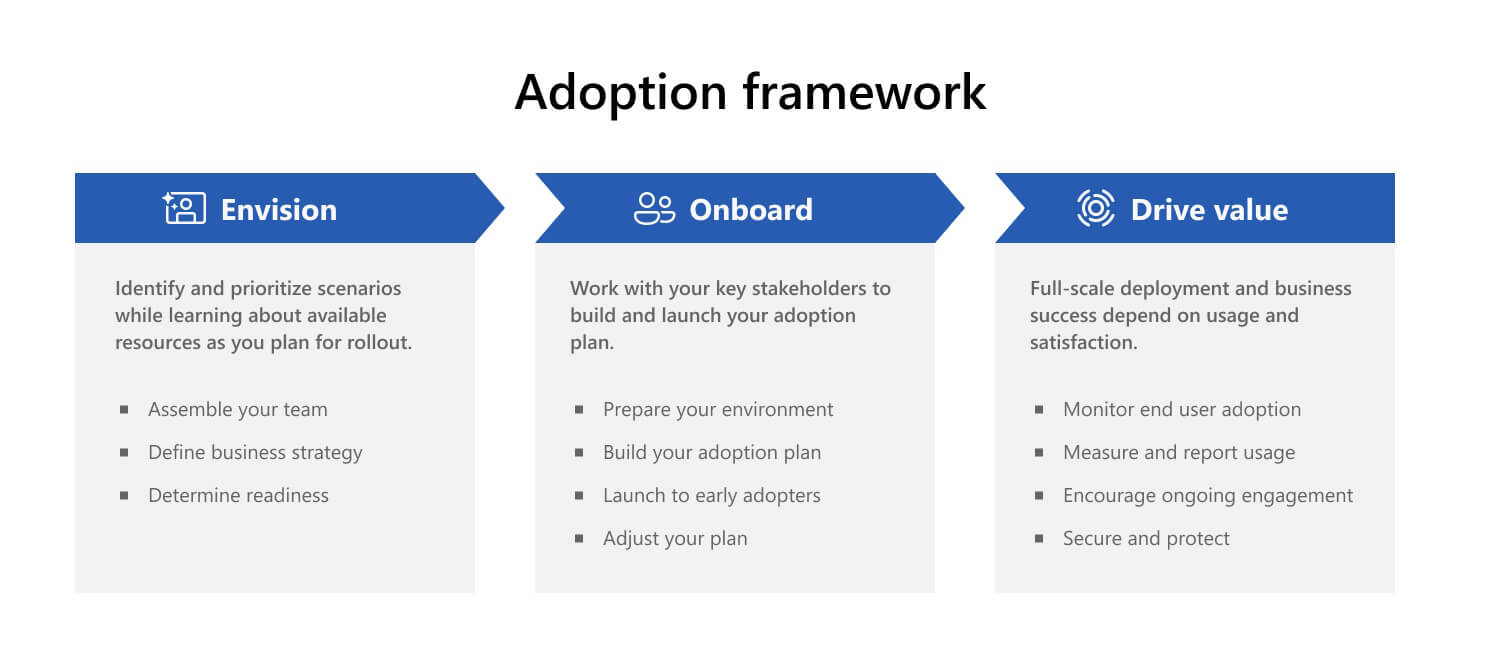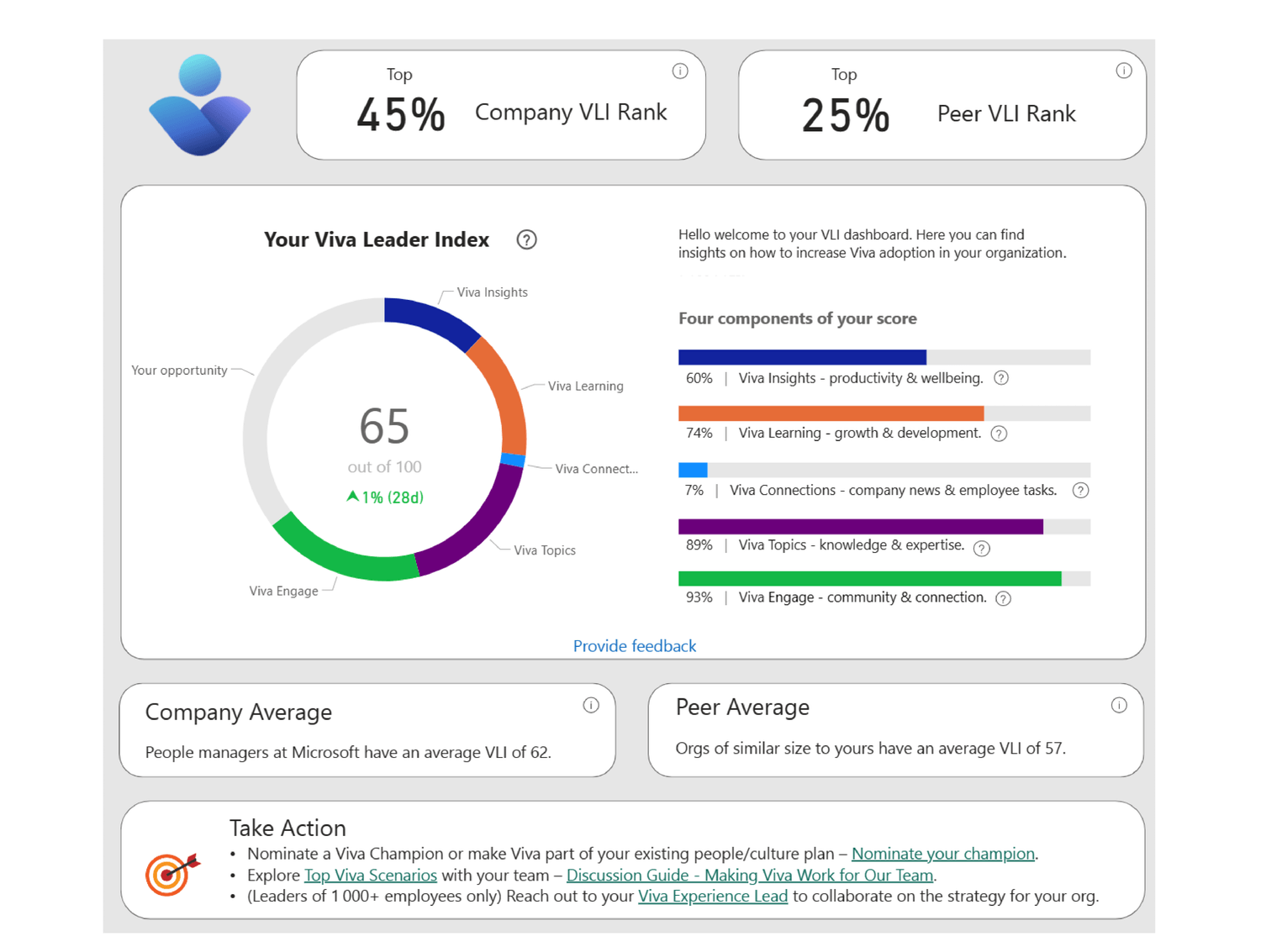 How do you turn data into knowledge? Once you have it, how to you turn that knowledge into action?
How do you turn data into knowledge? Once you have it, how to you turn that knowledge into action?
Adopting a new product across an organization as large as Microsoft is an enormous task, and we’re always expanding our knowledge about how to roll out a new tool or platform more effectively. Product adoption data is at the core of how we build that knowledge — and how we implement the strategy that goes along with it.
“When it comes to driving adoption, the key to success is to identify the insights we need to deliver success upfront,” says Nathalie D’Hers, corporate vice president of employee experience at Microsoft. “We define those success measures then ensure we have the right data to meet our objectives.”
[Check out our Microsoft Viva adoption guide. Visit our Microsoft Viva content suite to learn how work life is better at Microsoft with Viva. Learn how we’re creating the digital workplace at Microsoft.]

The discipline of deployment
The transition to a modern, hybrid workplace has introduced new challenges into the product adoption process.
“The first challenge in a remote or hybrid environment is awareness because it’s really difficult to get users’ attention,” says Amy Ceurvorst, senior business program manager and adoption specialist with Microsoft Digital (MSD). “Now you’re competing against messages, chats, and emails to grab your employees’ attention, so we’ve had to try a bunch of different strategies to help users engage with a new product.”
Over time, we’ve learned some key lessons about driving effective adoption:
- Change doesn’t happen automatically—Employees need encouragement and guidance, or they’ll simply stick with existing technology.
- Buy-in from leadership matters—Engaged executives are effective champions for wide-reaching rollouts.
- Targets need to be measurable—If it doesn’t get measured, it won’t get done.
- Learn from the process and each other—Every adoption is an opportunity to build knowledge and improve processes, and collaboration provides valuable insights.
These principles have helped us build out an adoption process that flows naturally through envisioning, onboarding, and driving value by measuring success. Each stage of that journey involves thoughtful consideration, collaboration, and preparation.

Capturing the right data
But how do we ensure we’re making the most of the adoption journey? The answer is in the data.
The first challenge is securing the right data to meet our goals for each stage of the adoption journey, whether we’re building out our vision for a new tool, generating buy-in from executive sponsors, or demonstrating the success of a rollout.
That’s where our Employee Experience Insights team comes in. They’re responsible for looking at the experiences we support at Microsoft and collecting that data. Through collaboration with technical teams and change managers, they source and collocate the information we need to inform our deployments.
“We start with operational data from different sources, including services, applications, and devices,” says Miguel Uribe, principal product manager for Employee Experience Insights. “We put that together with enterprise data like employee profiles, support tickets, and survey results, and then use it to discover knowledge about how the user is perceiving the experience.”
Turning subjective, written responses into useful data can be a challenge, but Miguel’s team leverages machine learning and natural language processing to summarize and aggregate large swathes of feedback into sentiment scores and other useful information.
To protect employee privacy and ensure compliance with confidentiality standards, our data professionals work with our Human Resources and Privacy teams as well as our Corporate, External, and Legal Affairs team. They provide the guidance to ensure that user data is anonymized and aggregated so it doesn’t violate our employees’ privacy.
You need to give leaders a reason to buy into a tool’s value, articulate how you’ll measure success, develop targets to track against, and provide specific actions they can take to be successful.
—Marcus Young, employee experience director, Microsoft Digital
The goal is to enable a HEART analytics model that provides insights across five aspects of usage: happiness, engagement, adoption, retention, and task value. All of that data provides rich context, not just for guiding future rollouts, but for engaging sponsors throughout the ongoing adoption. The HEART framework is a set of user-centered metrics used to evaluate the quality of a user experience and to help measure the impact of UX changes.
Inspiring sponsors to drive Microsoft Viva adoption
Our recent Microsoft Viva rollout is a powerful example of good data’s effect on executive sponsorship. When Viva became available, MSD led the platform’s adoption across our more than 200,000 employees. Check out our Microsoft Viva adoption guide to get tips for deploying Viva at your company.
“We knew from experience that active and visible sponsorship is the number one factor for success when you roll out a change,” says Marcus Young, employee experience director with MSD. “You need to give leaders a reason to buy into a tool’s value, articulate how you’ll measure success, develop targets to track against, and provide specific actions they can take to be successful.”
To meet these needs, the team combined usage data with gamification, automated recommendations, and a stylish user interface to let leaders know where their organizations stand within our Microsoft Viva rollout. We called it the Microsoft Viva Leader Index (VLI).

Through this tool, any leader managing more than 20 people can navigate to an internal website that automatically detects their role and organization. The VLI then delivers an all-up view of Microsoft Viva usage across that leader’s team, including information about individual modules, how their team stacks up against their peers and the entire organization, and automated recommendations for how they can advance adoption.
This simple and engaging tool provides everything a leader needs to gauge their organization’s adoption success and work toward their goals. It’s a powerful example of what data can do when paired with purpose and personalization.
Measuring impact and managing knowledge
All throughout the rollout process, adoption specialists from our Employee Experience Success team actively consider the cycle of envisioning, onboarding, and driving value. As a deployment matures, they can use data to inform the process of their next rollout.

The Employee Experience Insights team collaborates with change management practitioners to incorporate adoption activities like localized comms, office hours, or sponsor influencing through our Early Adopter Program. That way, they can find correlations between adoption activities and spikes in usage to identify which methods drive the best results.
In Microsoft Viva’s case, we discovered that attention-grabbing, one-minute demos and direct-to-employee communications through Microsoft Teams were the most effective ways to boost adoption. Insights from this test-and-learn process mean our adoption specialists will be more prepared to support the next rollout.
“It’s hard to compete for people’s time,” Ceurvorst says. “So we’ve learned that we need to work hard to get into the sessions and spaces where they already work.”
On the product side, getting granular also supports a better development process and user experience moving forward. That depends on asking the right questions.
“Is there something happening making usage surge, or do we have significant drop-offs at certain times of year?” Ceurvorst asks. “There’s so much value in data from feature requests, bugs, and anonymized usage behaviors, and it helps us come up with insights we can share back to product groups.”
When our teams work together to capture effective adoption data, it produces meaningful impacts on the employee experience — from change management best practices to executive sponsorship, right through to product development. That means being intentional about the kind of information we capture and how we put it into action for ongoing and future adoption programs.
It’s all about creating a virtuous cycle, driven by data.

Here are some tips that you can use to build a plan for driving Microsoft Viva adoption at your company:
- Identify what success looks like, how to quantify it, and how to distribute accountability for that success to your leaders.
- Have the right data because it makes ROI powerfully tangible.
- Be diligent about advocating for your data desires to your data team.
- Deliver data with a human touch to energize sponsors and stakeholders.
- Align there is a plan and resourcing for collecting high-quality data signals.
- Work with legal professionals to understand the security and privacy rules and regulations around data.
- Identify who the primary users of your success measurement reporting will be, such as adoption specialists, and partner with them to define and design reports.

- Check out our Microsoft Viva adoption guide.
- Visit our Microsoft Viva content suite to learn how work life is better at Microsoft with Viva.
- Learn how we’re creating the digital workplace at Microsoft.
- Read more about helping Microsoft employees understand their value with the Total Rewards Portal.
- Get five key learnings from Microsoft’s Windows 11 upgrade.




